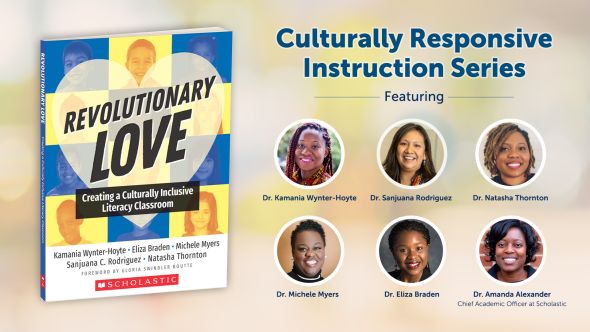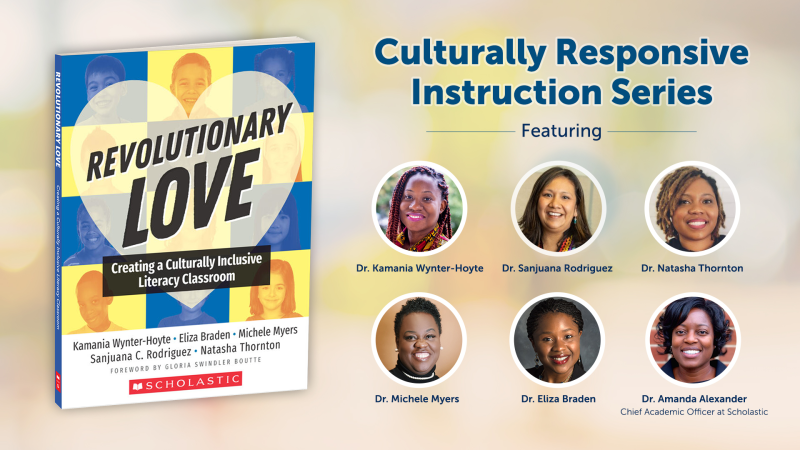 To help educators, schools, and districts affirm and celebrate students of all backgrounds through research-proven strategies, Revolutionary Love authors Kamania Wynter-Hoyte, Michele Myers, Sanjuana C. Rodriguez, Eliza Braden, and Natasha Thornton spoke with Scholastic Chief Academic Officer Amanda Alexander in a recent webinar to shed light on how to create a culturally inclusive classroom.
To help educators, schools, and districts affirm and celebrate students of all backgrounds through research-proven strategies, Revolutionary Love authors Kamania Wynter-Hoyte, Michele Myers, Sanjuana C. Rodriguez, Eliza Braden, and Natasha Thornton spoke with Scholastic Chief Academic Officer Amanda Alexander in a recent webinar to shed light on how to create a culturally inclusive classroom.
The Culturally Responsive Instruction series includes three webinars and follows the launch of the new Scholastic Literacy Framework. At the core of this framework is evidence-based literacy instruction, however, the framework also identifies responsiveness, equity and belonging, well-being, and joy as important components to driving learning outcomes. Using these values as a springboard, each presenter shares recommendations and tips on how to select diverse children’s books for classrooms and to promote more empathetic readers and writers.
The authors explain how educators can ignite revolutionary love in their classrooms. Through believing in the innate brilliance, unlimited potential, and cultural richness of their Black and Latine students and committing to centering the language and literacies of children in the classrooms, teachers can honor students in the context of their cultural identities.
1. Create a culturally inclusive inventory. Get to know your classroom by asking children to situate their lives as readers in a broader context, such as their families, their friends, their communities.
2. Analyze the books you read with your students: Talk about the representation of diverse identities and perspectives in the title and reflect on its broader cultural impact and relevance.
3. Try out character mapping: Select a character from the book and think about what this character says, thinks, feels, and how they act. Explore the perspectives and experiences of the characters in the story in order to broaden student’s understanding and empathy.
4. Encourage students to think critically: Ask your students to jot down what they are thinking while they are listening to the read-aloud or reading on their own. This helps students bring in their critical thinking skills, read the text closely, determine central ideas, and interpret unknown words.
5. Consider the character’s feelings: By teaching characterization and character feelings, teachers can encourage students to connect with others on a deeper, emotional level.
6. Begin blends and consonant clusters: Work on phonics blends prior to the read-aloud to help students recognize these blends in the text.
7. Spotlight suffixes and prefixes: Look at suffixes and prefixes in terms of word structure and morphology. Students can review these prefixes and suffixes before they read the text to help them read these words later and then aim to review them again, after the read-aloud.
8. Teach phonics before a read-aloud: Similarly, be sure to explicitly teach phonics such as vowel digraphs before reading the text together. After, challenge students to make up their own sentences using vowel digraphs to help their overall comprehension.
9. Teach in context to your students’ cultures: One way to help students process syllabication is through sharing each other’s names and their personal, cultural history. Knowing about another student’s name, as well as the syllables that make up that name, may help children draw connections when reading new words, decoding, and spelling.
10. Make an environmental print: Ask students to bring in photos of their favorite places that they visit with their families as a way to engage with characters’ lives and settings in the text.
- Kamania Wynter-Hoyte, Ph.D., is an Associate Professor at the University of South Carolina. Her teaching and scholarship center on the brilliance, joy, and stories of diverse young learners.
- Eliza G. Braden, Ph.D., is an Associate Professor of Elementary Education at the University of South Carolina. Her research interests include critical literacy and language practices of Black and Latinx children and their families, culturally relevant teaching, and critical multicultural children’s literature.
- Michele Myers, Ph.D., is an Assistant Professor at Wake Forest University. As a holistic, social justice educator, Dr. Myers is committed to ensuring that all children receive a humanizing education that honors their histories, heritages, literacies, languages, cultures, family structures, and communities as assets for learning. Dr. Myers recently co-authored The Educator’s Guide to Building Child & Family Resilience (Scholastic, 2023) with Linda C. Mayes.
- Sanjuana Carrillo Rodriguez, Ph.D., is an Associate Professor of Reading and Literacy Education at Kennesaw State University. Her work focuses on the early literacy development of emergent bilingual students, Latinx children’s literature, and social justice education in teacher education.
- Natasha Thornton, Ph.D., is an Assistant Professor of Elementary Education at Spelman College. Her research interests include culturally responsive literacy instruction, curricula affirming Black children’s histories and identities, and the intersection of teachers’ beliefs and practices.



